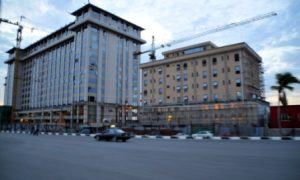The Monetary Policy Committee (MPC) of the Central Bank of Nigeria (CBN) is expected to hold its fifth meeting of the year on the 23rd and 24th of September. Like in previous meetings, we expect the Committee to consider developments in the global and domestic economy since the last policy meeting. On the global scene, major central banks are easing monetary policies as headline inflation trends closer to target levels.
Domestically, Nigeria’s GDP growth remains resilient, while headline inflation has decelerated for two consecutive months. However, near-term pressures suggest a potential uptick due to the substantial increase in the base price of PMS (+50.5% to NGN855.00/litre).
Additionally, we point out recent efforts by the CBN to stabilise the naira amid the persisting demand pressure. Consequently, we expect the CBN to adopt a cautious stance, likely opting to maintain the interest rate to support economic stability. Our baseline expectation is that the MPC will “HOLD” the Monetary Policy Rate (MPR) at 26.25% and retain all other policy parameters.
Domestic Economy to Grow Moderately in Q3-24
The domestic economy maintained its growth trajectory in Q2-24, driven primarily by a robust expansion in the oil sector (+10.15% y/y vs Q1-24: +5.70% y/y), while the non-oil sector growth (+2.80% y/y vs Q1-24: +2.80% y/y) stalled. We attribute improvement in the oil sector to the impact of (1) the FG’s unrelenting effort to curb crude oil theft and pipeline vandalism, (2) the development and integration of new oil fields, and (3) fewer terminal shut-ins.
Accordingly, average crude oil production output increased to 1.41 mb/d in Q2-24 compared to 1.22 mb/d in Q2-23. We note that the recent measures by the Nigerian Upstream Petroleum Regulatory Commission (NUPRC), including the deployment of end-to-end production monitoring and a mass balance methodology to accurately account for losses at oil terminals, alongside the addition of new oil fields, have supported crude oil output. As a result, we now estimate crude oil production to average 1.55 mb/d in Q3-24 (previous: 1.52mb/d).
Taking all factors into account, we forecast the oil sector real GDP to settle at 6.90% y/y in Q3-24 (Q2-24: +10.15% y/y | Q3-23: -0.85% y/y). On the other hand, growth in the non-oil sector was steady at 2.80% y/y in Q2-24, as economic activities were subdued by the combined impact of (1) high inflationary pressures, (2) elevated borrowing costs, and (3) naira depreciation.
We anticipate the sector will remain pressured by the existing challenges, causing the non-oil sector to slow to 2.73% y/y in Q3-24. Overall, we revise our real GDP growth estimate upwards to 2.96% y/y in Q3-24 (previous estimate: 2.83% y/y), with the full-year growth settling at 3.06% y/y in 2024FY (2023FY: +2.74% y/y). We expect the Committee to maintain optimism on GDP growth while retaining their forecast of 3.30% y/y in 2024FY.
Consumer Prices Slowed for Two Consecutive Months
Domestic inflationary pressures slowed for two straight months primarily due to the high statistical base from last year’s corresponding period. We highlight that headline inflation slowed by a faster pace of 125bps to 32.15% y/y in August (July: -80bps to 33.40% y/y). The breakdown showed that food prices slowed for the second consecutive month by 201bps to 37.52% y/y (July: 39.53% y/y), partly due to improved food supplies induced by the green harvest.
However, the core inflation continued to increase, rising by 12bps to 27.58% y/y (July: 27.47% y/y) due to the impact of higher PMS prices and lingering FX issues. On a month-on-month basis, inflation slowed by 6bps to 2.22% y/y (July: 2.28% m/m), supported by the slowdown in food prices. We expect the Monetary Policy Committee to recognise the consecutive two-month moderation in inflation, attributing this trend to base effect and the Central Bank of Nigeria’s tight monetary stance. However, the Committee is likely to express concern over the significant increase in fuel prices and its potential to exert upward pressure on inflation in the near term.
FX Volatility Remain Intact
The naira has remained volatile since the last monetary policy meeting on 23 July, given the limited FX supply amidst increased FX demand. At the same time, foreign investors have remained cautious primarily due to low investor confidence. However, we note the improved FX inflows into the Nigerian Autonomous Foreign Exchange Market (NAFEM), underpinned by increases in both local and foreign sources as total inflows rebounded by 21.4% m/m to USD2.34 billion in August (July: USD1.92 billion). Inflows from local sources increased by 15.5% m/m to USD1.94 billion in August (July: USD1.68 billion) driven by increased collections from Individuals (+162.5% m/m), Exporters (+28.3% m/m) and Non-Bank Corporates (+18.7% m/m) segments despite the weaker inflow from the CBN (-53.7% m/m).
At the same time, inflows from foreign sources increased by 62.1% m/m to USD394.50 million (July: USD243.30 million), although remained below the H1-24 average (USD790.57 million), reflecting still weak foreign investor confidence. Nonetheless, the NAFEM rate weakened by 1.7% to an average of NGN1,586.56/USD in August (July average: NGN1,560.32/USD) as FX demand continues to exceed overall supply.
Elsewhere, there has been sustained accretion to the FX reserves as the balance reached a 20-month high of USD36.94 billion (as of 13 September), partly reflecting inflows from the proceeds of the recently concluded domestic FGN US Dollar bond (c. USD900.00 million). We expect the MPC to acknowledge the increased naira volatility, attributing it to the unabating demand pressure while encouraging the CBN to sustain its FX supply to the market to stabilise the naira.
Global Central Banks Embark on Policy Easing
The Federal Open Market Committee (FOMC) unanimously voted to reduce the federal funds rate by 50 basis points to 4.75% – 5.00% at their September 18 meeting, marking the first rate cut since March 2020. The decision reflects the Committee’s confidence in progress towards the 2.0% inflation target and a balanced outlook on employment and inflation risks. The FOMC indicated that future rate adjustments would be data-dependent, considering evolving economic conditions and potential risks. Despite this cautious stance, the Fed’s dot plot suggests an additional 50 basis point cut before year-end. Similarly, the Governing Council of the European Central Bank (ECB) voted to ease the deposit lending facility further by 25bps to 3.50% (Previously 3.75%), citing slower Eurozone economic growth and inflation approaching the target rate (2.0%).
The Committee also lowered its main refinancing operations and marginal lending facility rates by 60bps apiece to 3.65% and 3.90% (previously: 4.25% and 4.50%, respectively). Given the underlying tone and near-term inflationary pressures from higher wages, we anticipate the ECB will maintain a cautious stance, likely holding rates at the October meeting. The Bank of England (BoE), meanwhile, voted 8 – 1 to keep their policy rate at 5.0% in September after a 25bps cut in August, focusing on returning inflation to the 2.0% target sustainably.
Despite this hold, the BoE reduced their stock of UK government bond purchases by GBP100.00 billion to GBP558.00 billion. The Committee affirmed their commitment to maintaining a restrictive monetary policy stance until they gain greater confidence in a sustainable return of inflation to the 2.0% target. Despite this cautious outlook, the BoE will likely implement a further 25bps reduction in the benchmark interest rate to 4.75% at the upcoming November meeting. Consequently, we expect the Monetary Policy Committee to adopt a more optimistic view regarding potential capital inflows to emerging markets, as declining global interest rates are likely to mitigate risk aversion and attract foreign investments.
MPC to Retain the MPR at 26.75%
We think the Monetary Policy Committee faces a pivotal decision – either maintain current rates to allow previous hikes to fully impact the economy or continue rate increases to reinforce gains from prior adjustments owing to the elevated inflation risks exacerbated by the recent rise in PMS price.
Our baseline expectation is for the MPC to adopt a “HOLD” stance in the forthcoming meeting, as we expect the Committee to refer to the recent decline in headline inflation, even as inflation risks are now strongly tilted to the upside.
Additionally, the intensification of global monetary policy easing reduces the risk of capital flight from developing markets like Nigeria, lessening the pressure for defensive rate hikes. Also, we highlight the dovish signals from the CBN coming off the apex bank’s adjustment of the asymmetric corridor to +500/-100bps around the MPR.
Specifically, the CBN limited the Standing Deposit Facility (SDF) rate of 25.75% on deposits of up to NGN3.00 billion, with a fixed rate of 19.0% on excess deposits, thus discouraging banks’ utilisation of this window. As a result, fixed income yields have pared down over time. Given these developments, we expect the MPC to keep the policy rate at 26.75% while retaining all other parameters.
Cordros



























